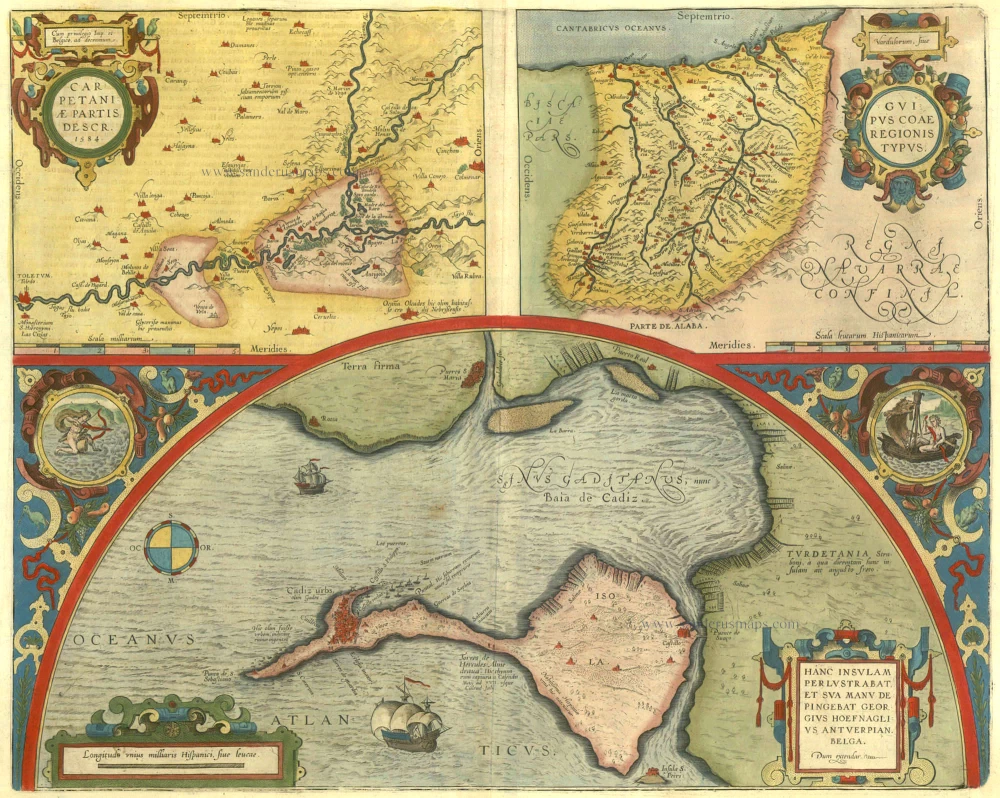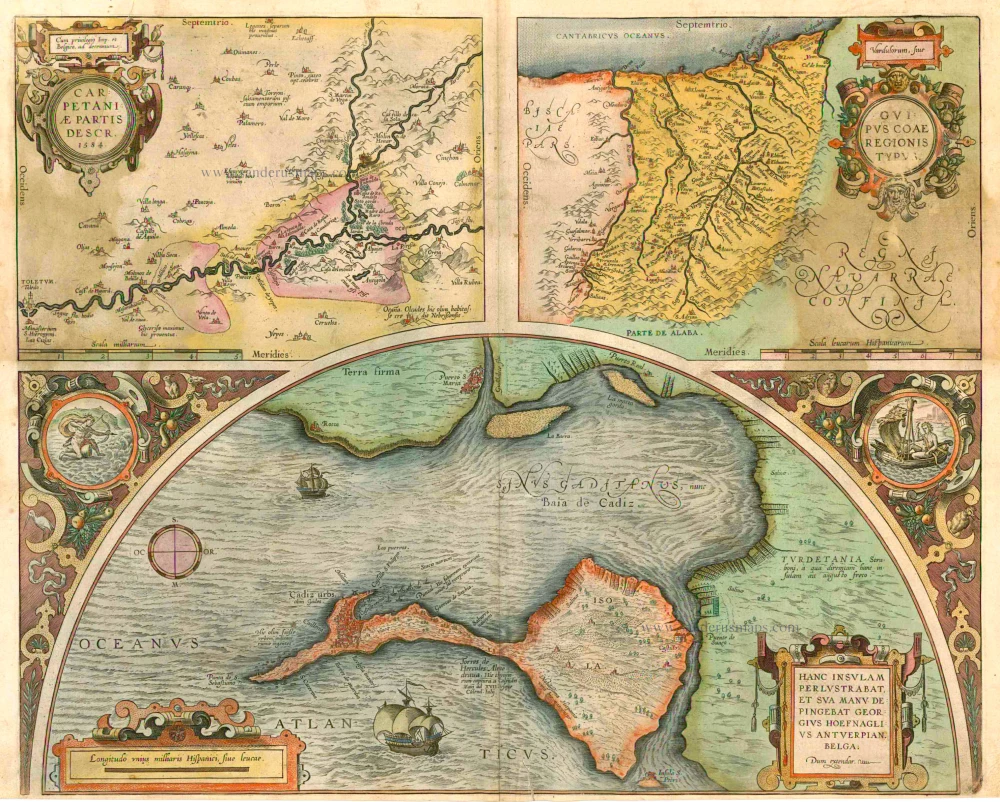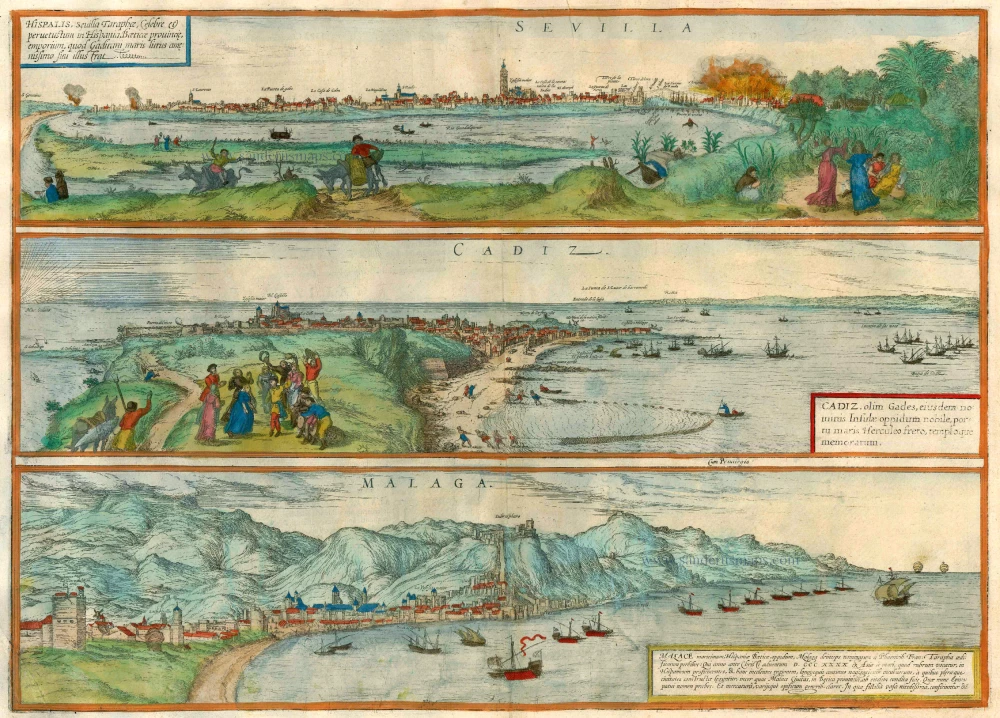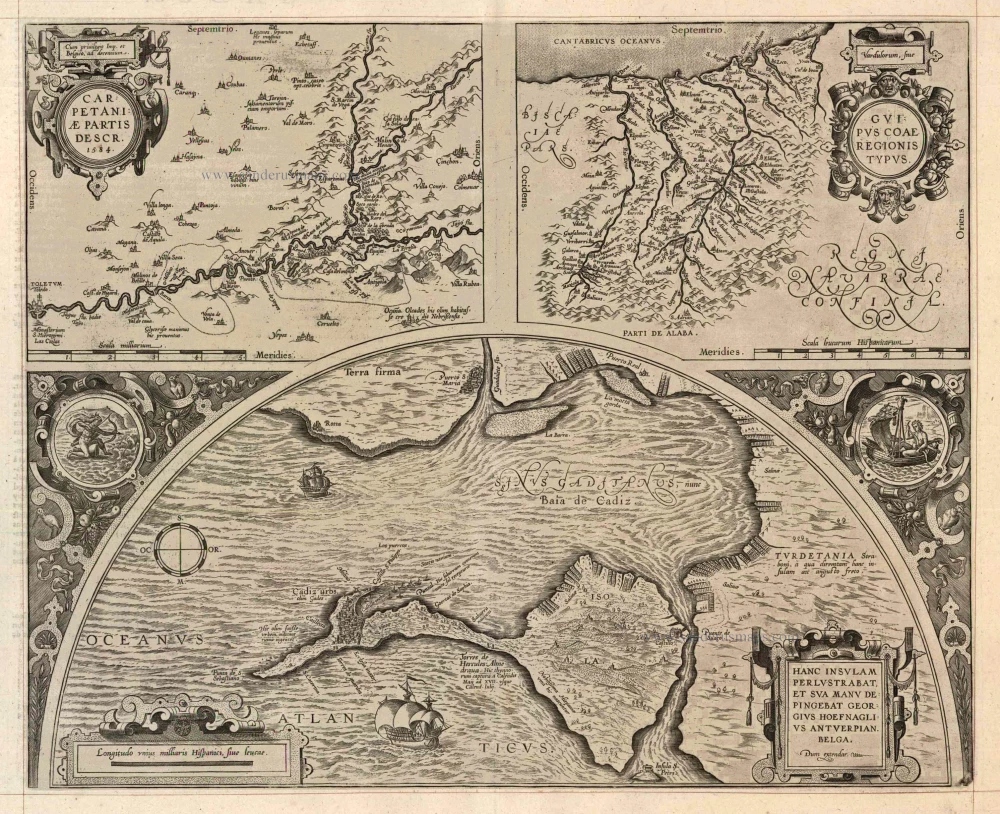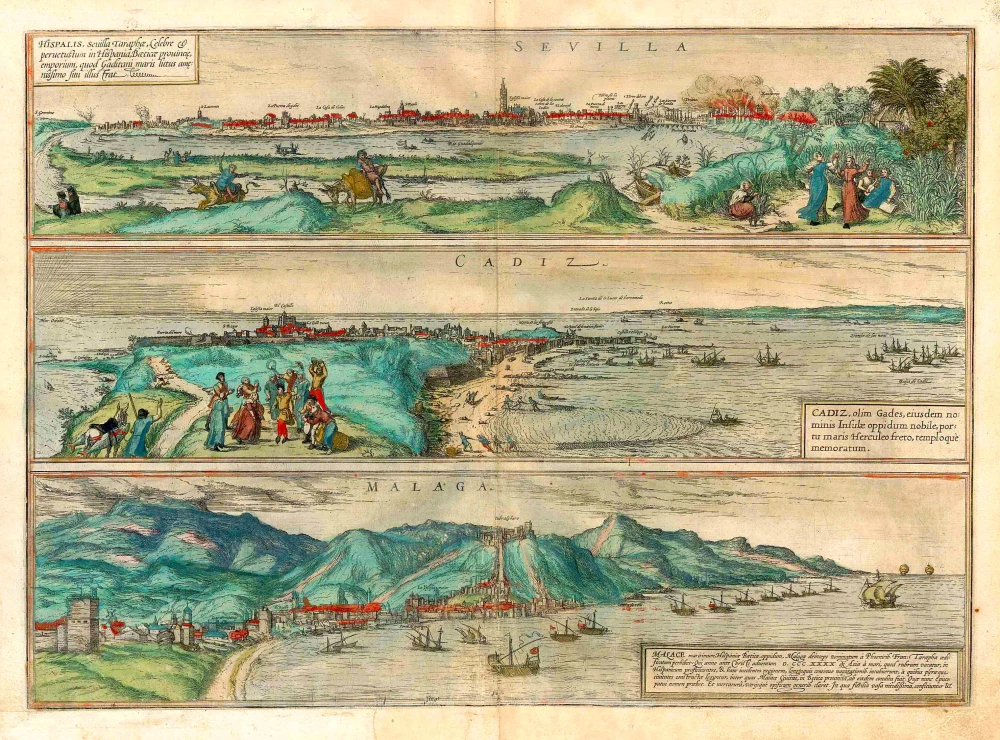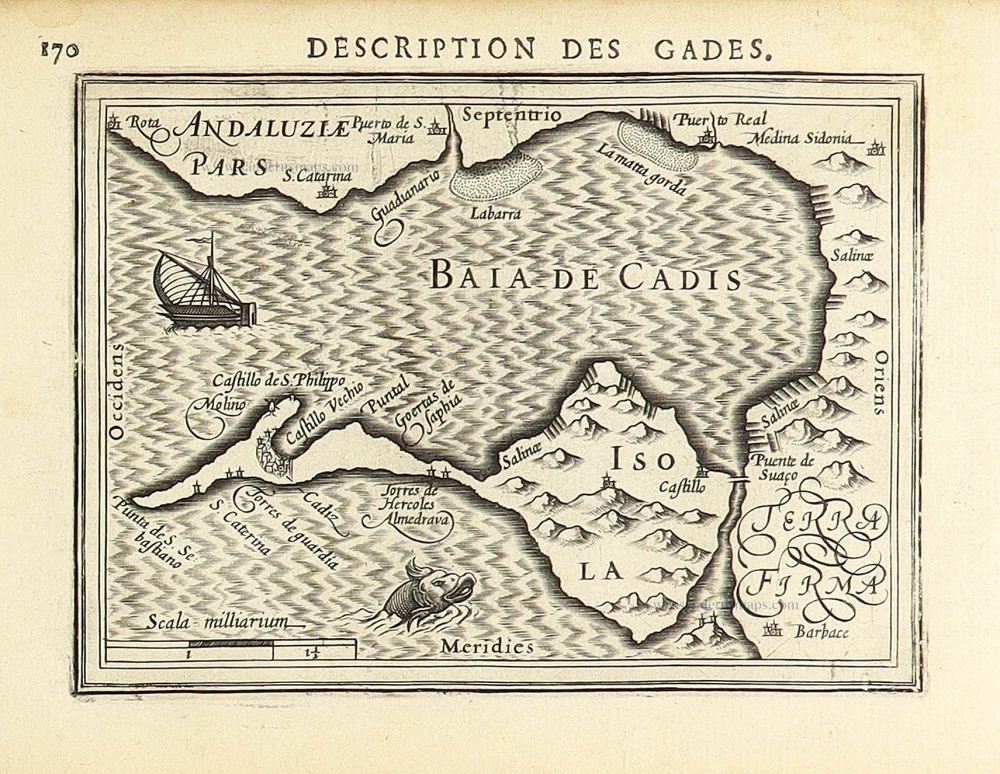Cadiz, by Braun Georg & Hogenberg Frans. 1623
TRANSLATION OF CAPTION: Cadiz, seen from the western parts of the island.
COMMENTARY BY BRAUN (on verso): "Here can be seen in particular the skill of the inhabitants of Cadiz at catching fish. They wall off part of the sea with stones and rocks piled on each other so that when the tide goes out, they cannot escape, and they can be caught very easily, even without a net, with the hands."
The plate shows Cadiz seen across the narrow peninsula from the Atlantic. In the foreground stands the chapel of St Sebastian. A group of fishermen has been included to illustrate the fishing method described in the text. Also visible at the lower edge is the figure of Hercules, the legendary founder of the city, subduing the Nemean Lion - in this instance, even two. On the left, as a picture within a picture, Hoefnagel shows crews being enrolled for service on the galleys by casting lots and subsequently being taken on board. A bastion is included on the right to symbolise Cadiz's military importance. (Taschen)
Above the left cartouche, a "leopard dog" is shown, brought back from the West Indies in 1565, and above the right cartouche, a Peruvian pica brought back in 1578.
At the top of the view is a fish caught in Cadiz in 1564.
Braun G. & Hogenberg F. and the Civitates Orbis Terrarum.
The Civitates Orbis Terrarum, also known as the 'Braun & Hogenberg', is a six-volume town atlas and the most excellent book of town views and plans ever published: 363 engravings, sometimes beautifully coloured. It was one of the best-selling works in the last quarter of the 16th century. Georg Braun, a skilled writer, wrote the text accompanying the plans and views on the verso. Many plates were engraved after the original drawings of a professional artist, Joris Hoefnagel (1542-1600). The first volume was published in Latin in 1572 and the sixth in 1617. Frans Hogenberg, a talented engraver, created the tables for volumes I through IV, and Simon van den Neuwel made those for volumes V and VI. Other contributors were cartographers Daniel Freese and Heinrich Rantzau, who provided valuable geographical information. Works by Jacob van Deventer, Sebastian Münster, and Johannes Stumpf were also used as references. Translations appeared in German and French, making the atlas accessible to a broader audience.
Since its original publication of volume 1 in 1572, the Civitates Orbis Terrarum has left an indelible mark on the history of cartography. Seven more editions followed the first volume in 1575, 1577, 1582, 1588, 1593, 1599, and 1612. Vol.2, initially released in 1575, saw subsequent editions in 1597 and 1612. The subsequent volumes, each a treasure trove of historical insights, graced the world in 1581, 1588, 1593, 1599, and 1606. The German translation of the first volume, a testament to its widespread appeal, debuted in 1574, followed by the French edition in 1575.
Several printers were involved: Theodor Graminaeus, Heinrich von Aich, Gottfried von Kempen, Johannis Sinniger, Bertram Buchholtz, and Peter von Brachel, all of whom worked in Cologne.
Georg Braun (1541-1622)
Georg Braun, the author of the text accompanying the plans and views in the Civitates Orbis Terrarum, was born in Cologne in 1541. After his studies in Cologne, he entered the Jesuit Order as a novice, indicating his commitment to learning and intellectual pursuits. In 1561, he obtained his bachelor's degree; in 1562, he received his Magister Artium, further demonstrating his academic achievements. Although he left the Jesuit Order, he continued his studies in theology, gaining a licentiate in theology. His theological background likely influenced the content and tone of the text in the Civitates Orbis Terrarum, adding a unique perspective to the work.
Frans Hogenberg (1535-1590)
Frans Hogenberg was a Flemish and German painter, engraver, and mapmaker. He was born in Mechelen as the son of Nicolaas Hogenberg.
By the end of the 1560s, Frans Hogenberg was employed upon Abraham Ortelius's Theatrum Orbis Terrarum, published in 1570; he is named an engraver of numerous maps. In 1568, he was banned from Antwerp by the Duke of Alva and travelled to London, where he stayed a few years before emigrating to Cologne. He immediately embarked on his two most important works, the Civitates, published in 1572 and the Geschichtsblätter, which appeared in several series from 1569 until about 1587.
Thanks to large-scale projects like the Geschichtsblätter and the Civitates, Hogenberg's social circumstances improved with each passing year. He died as a wealthy man in Cologne in 1590.
Gades ab Occiduis Insulae Partibus.
Item Number: 22059 Authenticity Guarantee
Category: Antique maps > Europe > Spain and Portugal
Antique map - a view of Cadiz, by Georg Braun and Frans Hogenberg.
With two inset vignettes.
Title: Gades ab Occiduis Insulae Partibus.
Cartographer: Georg Hoefnagel
Date of the first edition: 1596
Date of this map: 1623
Date on map: 1564
Copper engraving, printed on paper.
Size (not including margins): 37 x 49cm (14.4 x 19.1 inches)
Verso text: Latin
Condition: Original coloured, lower centrefold reinforced, some smudging at lower centre.
Condition Rating: B+
References: Van der Krogt 4, #711; Taschen, Br. Hog., p.350; Fauser, #2183.
From: Urbium Praeipuarum Mundi Theatrum Quintum Auctore Georgio Braunio Agrippinate. Part 5. Köln, Petrus von Brachel, 1623. (Van der Krogt 4, 41:1.5)
TRANSLATION OF CAPTION: Cadiz, seen from the western parts of the island.
COMMENTARY BY BRAUN (on verso): "Here can be seen in particular the skill of the inhabitants of Cadiz at catching fish. They wall off part of the sea with stones and rocks piled on each other so that when the tide goes out, they cannot escape, and they can be caught very easily, even without a net, with the hands."
The plate shows Cadiz seen across the narrow peninsula from the Atlantic. In the foreground stands the chapel of St Sebastian. A group of fishermen has been included to illustrate the fishing method described in the text. Also visible at the lower edge is the figure of Hercules, the legendary founder of the city, subduing the Nemean Lion - in this instance, even two. On the left, as a picture within a picture, Hoefnagel shows crews being enrolled for service on the galleys by casting lots and subsequently being taken on board. A bastion is included on the right to symbolise Cadiz's military importance. (Taschen)
Above the left cartouche, a "leopard dog" is shown, brought back from the West Indies in 1565, and above the right cartouche, a Peruvian pica brought back in 1578.
At the top of the view is a fish caught in Cadiz in 1564.
Braun G. & Hogenberg F. and the Civitates Orbis Terrarum.
The Civitates Orbis Terrarum, also known as the 'Braun & Hogenberg', is a six-volume town atlas and the most excellent book of town views and plans ever published: 363 engravings, sometimes beautifully coloured. It was one of the best-selling works in the last quarter of the 16th century. Georg Braun, a skilled writer, wrote the text accompanying the plans and views on the verso. Many plates were engraved after the original drawings of a professional artist, Joris Hoefnagel (1542-1600). The first volume was published in Latin in 1572 and the sixth in 1617. Frans Hogenberg, a talented engraver, created the tables for volumes I through IV, and Simon van den Neuwel made those for volumes V and VI. Other contributors were cartographers Daniel Freese and Heinrich Rantzau, who provided valuable geographical information. Works by Jacob van Deventer, Sebastian Münster, and Johannes Stumpf were also used as references. Translations appeared in German and French, making the atlas accessible to a broader audience.
Since its original publication of volume 1 in 1572, the Civitates Orbis Terrarum has left an indelible mark on the history of cartography. Seven more editions followed the first volume in 1575, 1577, 1582, 1588, 1593, 1599, and 1612. Vol.2, initially released in 1575, saw subsequent editions in 1597 and 1612. The subsequent volumes, each a treasure trove of historical insights, graced the world in 1581, 1588, 1593, 1599, and 1606. The German translation of the first volume, a testament to its widespread appeal, debuted in 1574, followed by the French edition in 1575.
Several printers were involved: Theodor Graminaeus, Heinrich von Aich, Gottfried von Kempen, Johannis Sinniger, Bertram Buchholtz, and Peter von Brachel, all of whom worked in Cologne.
Georg Braun (1541-1622)
Georg Braun, the author of the text accompanying the plans and views in the Civitates Orbis Terrarum, was born in Cologne in 1541. After his studies in Cologne, he entered the Jesuit Order as a novice, indicating his commitment to learning and intellectual pursuits. In 1561, he obtained his bachelor's degree; in 1562, he received his Magister Artium, further demonstrating his academic achievements. Although he left the Jesuit Order, he continued his studies in theology, gaining a licentiate in theology. His theological background likely influenced the content and tone of the text in the Civitates Orbis Terrarum, adding a unique perspective to the work.
Frans Hogenberg (1535-1590)
Frans Hogenberg was a Flemish and German painter, engraver, and mapmaker. He was born in Mechelen as the son of Nicolaas Hogenberg.
By the end of the 1560s, Frans Hogenberg was employed upon Abraham Ortelius's Theatrum Orbis Terrarum, published in 1570; he is named an engraver of numerous maps. In 1568, he was banned from Antwerp by the Duke of Alva and travelled to London, where he stayed a few years before emigrating to Cologne. He immediately embarked on his two most important works, the Civitates, published in 1572 and the Geschichtsblätter, which appeared in several series from 1569 until about 1587.
Thanks to large-scale projects like the Geschichtsblätter and the Civitates, Hogenberg's social circumstances improved with each passing year. He died as a wealthy man in Cologne in 1590.





